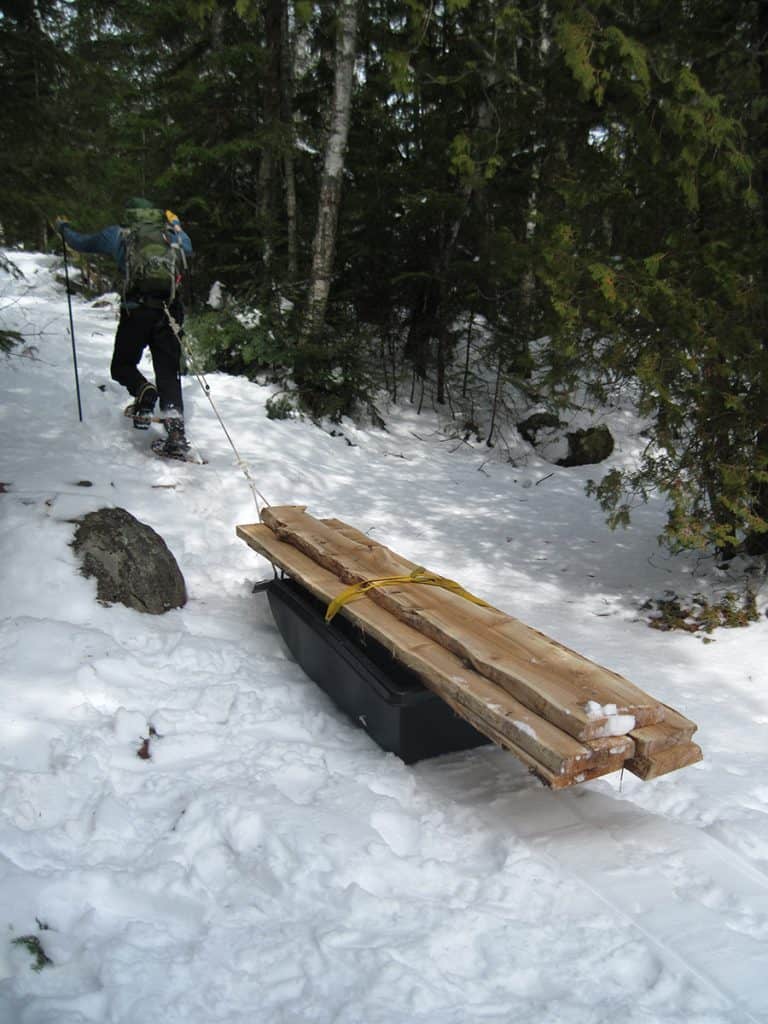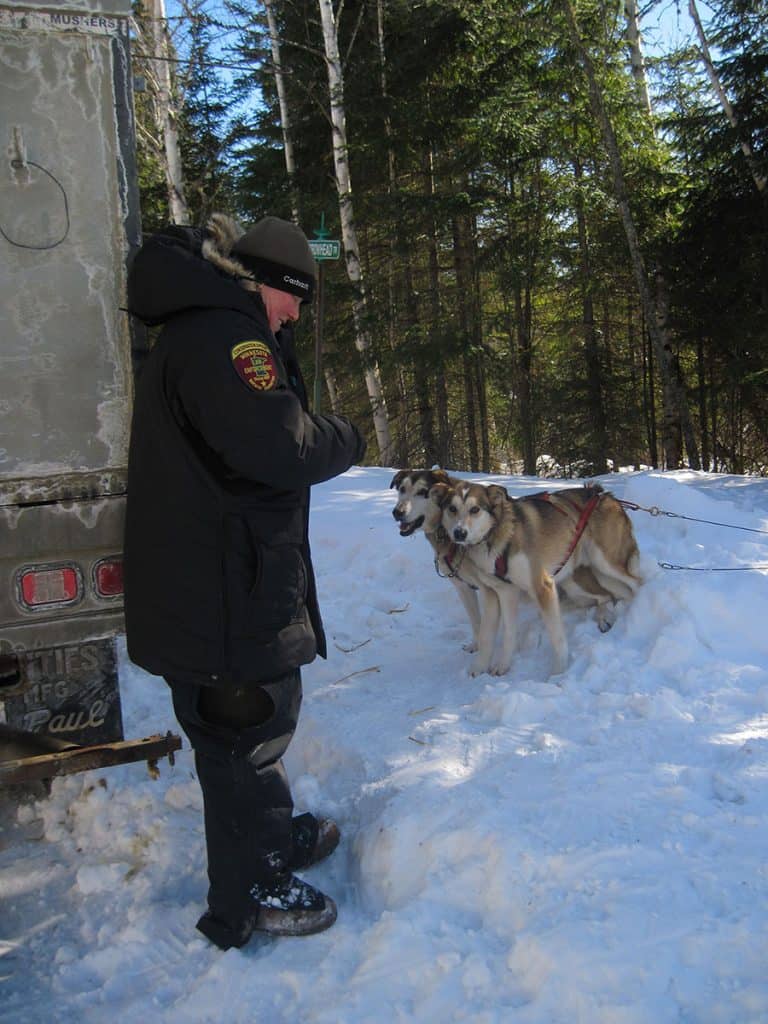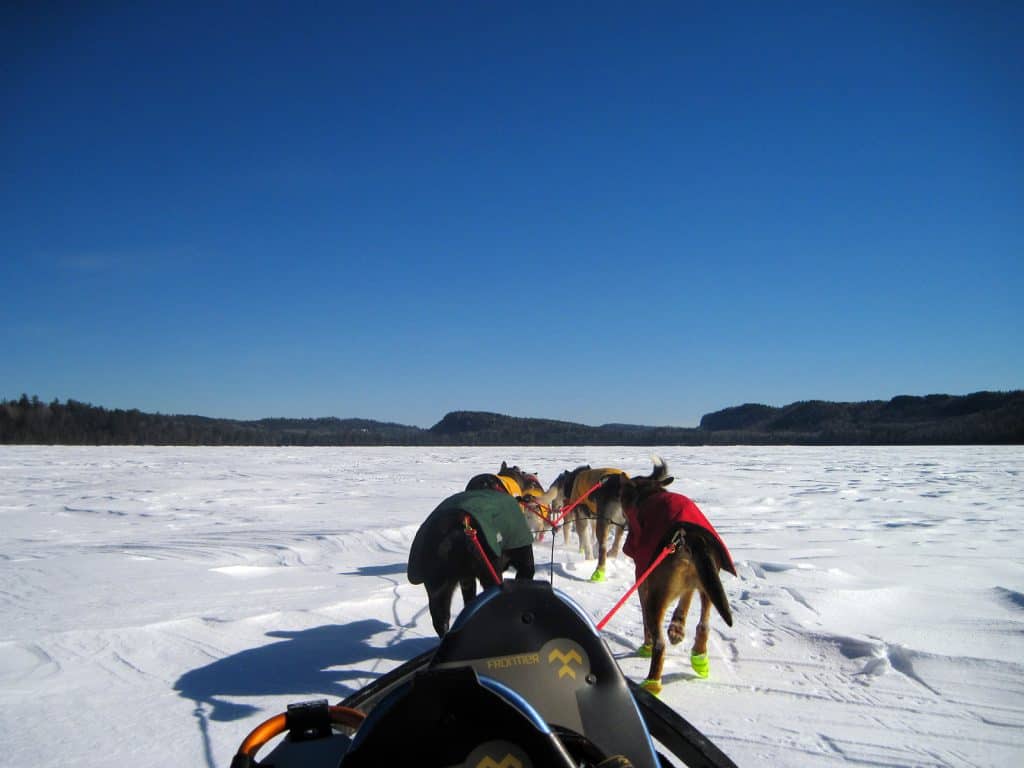
For many Boundary Waters Canoe Area Wilderness visitors, it’s hard to separate a BWCAW experience from dipping a paddle into a lake’s smooth surface or falling asleep in your tent listening to a loon call echo from the distant shore. Yet for nearly half the year, winter blankets the Boundary Waters in icy stillness.

Although visitorship to the Boundary Waters declines precipitously as lakes freeze and loons fly south, the BWCAW is always open and that means U.S. Forest Service wilderness rangers are working to maintain and enforce laws in the federally designated wilderness area. When snow covers Boundary Waters lakes and portages, wilderness rangers turn to sled dogs, snowshoes, and cross-country skis to complete their work.
Just like during the summer, wilderness rangers’ main objective during a winter patrol is contact with the ice anglers, winter campers, and other BWCAW winter visitors, according to Cathy Quinn, a wilderness ranger for more than 20 years on the Gunflint Ranger District based in Grand Marais, MN. The snowy landscape also provides a unique opportunity for wilderness rangers to freight in supplies for campsites and portages.
“It can be a big time saver if conditions are right,” Quinn said.
Wilderness rangers aren’t exempt from the BWCAW’s motor restrictions, which means every fire grate, latrine, or boardwalk you’ve ever used inside the paddle-only areas is there thanks solely to manpower. Many of these items are brought in during the open water season, which sometimes means a 50-60 pound fire grate is thrown in the bottom of a Duluth pack and portaged several times to reach a remote campsite. In winter, the snowpack provides wilderness rangers with the slightly less labor-intensive option of pulling, rather than carrying, in these heavy items.
“Things that are really handy to haul in [during the winter] are boardwalk materials,” Quinn said.
Last winter, Quinn and her coworkers hauled in materials for 250 feet of boardwalk on the portage between Misquah to Little Trout Lakes, a 190-rod portage located approximately four miles south of Poplar Lake. The materials were then stashed in the woods until July when a volunteer crew from the Northwoods Volunteer Connection paddled in to complete the project.

“Where it’s really handy are areas where there are long portages right away,” she said of winter hauling.
While it’s not a big deal for rangers to paddle latrines and other clunky items down large lakes like Seagull or Brule, it can be helpful to have a stash of supplies in areas such as Alton and Tuscarora Lakes and entry points off the Lima Grade where rangers (and visitors) spend the start of their Boundary Waters trips mostly portaging rather than paddling, she said.
When federal budget, wilderness ranger experience, and team availability allow, sled dog teams provide wilderness rangers with “a really fast way to get around” the Boundary Waters in the winter, said Quinn. However, because of the rugged terrain on the eastern side of the Boundary Waters, she said supplies like those in the Misquah/Little Trout boardwalk project are most often brought in by wilderness rangers snowshoeing or skiing while pulling six-foot Otter sleds with the materials lashed to them. “We’re the dogs over here,” Quinn joked about her and her coworkers.
On the western side of the Boundary Waters where the terrain is flatter, sled dog teams are a more common way for wilderness rangers to both patrol and freight in supplies, she said.
Occasionally the U.S. Forest Service teams up the MN DNR so wilderness rangers can patrol the Boundary Waters in tandem with a conservation officer. In past winters, Quinn has gone out with Mary Manning, a Hovland based conservation officer and musher who uses a 6-8 dog team to travel through the Boundary Waters. With the speed of the dog team, Quinn and Manning can make contact with many BWCAW visitors in a day and check for permits, fishing licenses, and address any violations they might observe. By traveling together, they’re able to provide effective and efficient visitor contact since they can help BWCAW visitors understand both federal and state laws and regulations.
While you might not expect to see a soul during your winter Boundary Waters adventure, patrolling the Boundary Waters is a year-round business, so don’t be surprised if a wilderness ranger skis up and asks to see your BWCAW permit.
For More Information:
U.S. Forest Service Gunflint Ranger District
Northwoods Volunteer Connection


